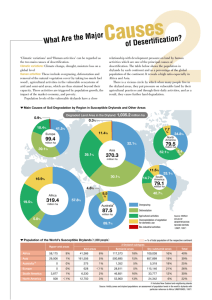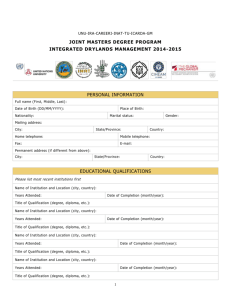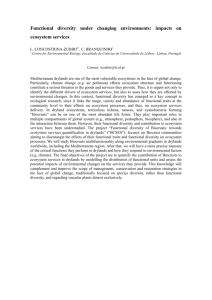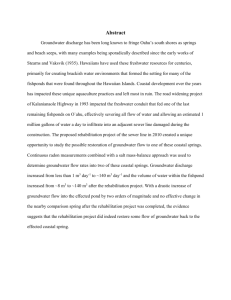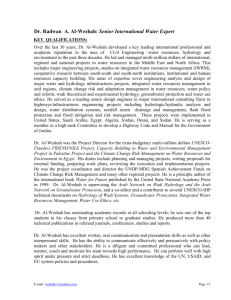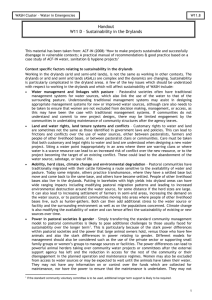Summary Report of the Workshop Zafar Adeel and Fatma A-R. Attia
advertisement
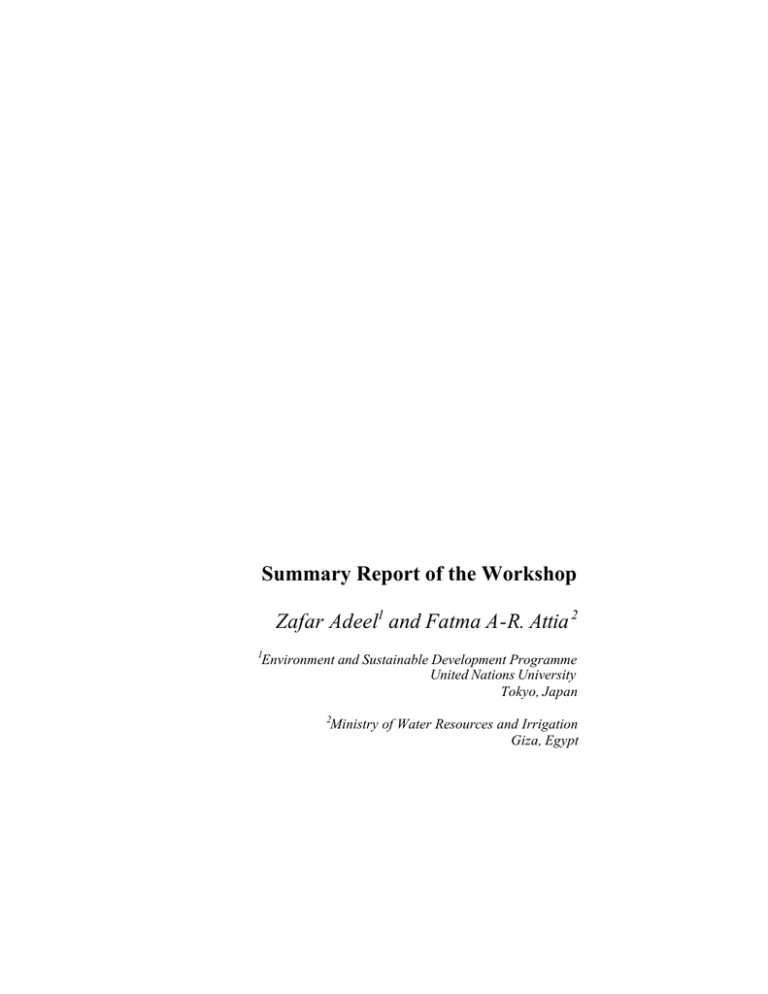
Summary Report of the Workshop Zafar Adeel1 and Fatma A-R. Attia 2 1 Environment and Sustainable Development Programme United Nations University Tokyo, Japan 2 Ministry of Water Resources and Irrigation Giza, Egypt 2 Adeel & Attia Workshop Overview T he 5th International Workshop: “Sustainable Management of Marginal Drylands - Application of Indigenous Knowledge for Coastal Drylands ” was jointly organized by the United Nations University (UNU), the United Nations Educational, Scientific and Cultura l Organization (UNESCO) and the International Center for Agricultural Research in the Dry Areas (ICARDA), in cooperation with the Bibliotheca Alexandrina, Egypt. The workshop comprised a two-day field investigative excursion in Northern Egypt, followed by two and a half days of technical sessions in Alexandria including paper presentations and discussions. The field excursion was coordinated by Dr. Fatma Abdel Rahman Attia and also supported by Dr. Boshra Salem. This workshop focused on the strategies for sustainable management in marginal drylands. These strategies are most critical for protection, conservation and reclamation or rehabilitation of these fragile ecosystems. Such strategies are closely linked to human development and quality of life in these marginal areas. The workshop also emphasized the use of indigenous knowledge and traditional technologies for sustainable management of marginal drylands. Some work undertaken on this issue by UNU and its partners was presented. In keeping with location of the workshop, a secondary focus was on management of coastal drylands ; this was adequately reflected in the organization of the field excursion and the workshop presentations. Summary Report of the Field Excursion Day 1: Saturday, 21 September 2002 Wadi El-Natrun Area Wadi E l-Natrun (“Natrun” is derived from the Latin word “natrium” for the element sodium) is a part of the Western Desert adjacent to the Nile Delta. It is a narrow depression located approximately 90 km south of Alexandria and 110 km northwest of Cairo. The history of the area dates back to the Pharaohs, who used salts from the lakes for the process of mummification. The Romans extracted silica for glass from here. During the British era, a Summary Report of the Workshop 3 railroad system was built to move the salt from Wadi El-Natrun to Cairo. The importance of the wadi to Christians dates goes back to the 4th century, as Wadi El-Natrun was one of the stops during the Holy Family’s visit to Egypt. The climate of Wadi El-Natrun is arid (low and very variable rainfall, a long dry summer, a high rate of evaporation, low humidity, etc.). The annual average rainfall is about 55 mm, mostly in November and December. The mean annual temperature varies from 22.8°C in January to 28.8°C in August. Wind velocities usually range between 11 km/h and 20 km/h in winter and summer, respectively. Winds are usually from the north, northeast and northwest. The wadi is oriented in a NW-SE direction between the latitudes 30° 17' and 30° 33' N; and between longitude 30° 02' and 30° 30' E. Its length is about 50 km, and it is narrow at both ends (2.6 km in the north and 1.24 km in the south) and wider in the middle (8 km). The wadi lies 23 m below sea level and is characterized by a series of 20 small disconnected lakes in the bottom of the wadi. Ten of these lakes are relatively larger in size and have permanent water reservois in all or some of their parts. The largest lakes are Lake AlGaar in the northwest side of the depression and Lake Umm Risha in the southeast direction. Other smaller, but almost permanent, lakes are Al-Hammra, Al-Fasda, Al-Bida, Al-Khadra, Al-Zugm (Zaagig) and Abu-Gubara. Water enters the Wadi through two routes, as springs in some of the lakes, like the one found in Lake Hamara , and as very small streams on the sloping edges of the lakes. The main geological feature is the Wadi El-Natrun anticline, which trends in a northwest direction for about 35 km, from Ras ElSolymania in the north to Deir Macarious in the south. The axis is sinuous passing through most of the lakes of Wadi El-Natrun. The main geological formation of interest is the Moghra formation, which covers a wide area of the northern portion of the Western Desert, comprising sand and clayey sandstone with siltstone intercalations. Groundwater quality is moderate (1,000-2,000 ppm, TDS) in the south and southwest, changing to poor (2,000-5,000 ppm TDS) in 4 Adeel & Attia the east. The increase in salinity is also encountered at greater depths. Groundwater is a mixture of fossil and renewable groundwater. The main recharge source is groundwater lateral seepage from the Nile delta aquifer system and the infiltrating rainfall water. About 4 billion m3 of brackish groundwater is believed to be stored in the region. No utilization of such groundwater is practiced at present. In theory, this brackish wate r can be used for agroindustrial development and for potable water supply after desalination. However, such utilization must only be considered after proper evaluation of its impacts, as most of the water resource is non-renewable. Al-Anba Saint Bishoy Monastery This is a Coptic Christian Monastery located near the Beni Salama village. Most of the monasteries in the area have been rebuilt and restored between the 8th and 11th centuries. The early churches had Roman/Coptic Architecture similar to the Bishoy Monastery. The monastery is divided into three sections, including communion, reading catechism, and a basin for sinners to bathe. There are five monasteries that are designated as important archaeological sites by the Egyptian government. Tourist numbering in thousands, both local and from overseas, visit the monasteries each year. The most important monasteries are Saint Macarious Monastery (Abu Makaar), Saint Bishoy Monastery, ElSuryan Monastery, the Virgin Mary Monastery (also known as Al Adrah), and the Monastery of Saint Bermos. These monasteries were attacked several times by the barbarian expeditions from the Sahara believing that they are full of treasures with treasures. After the Arab conquest of Egypt, the Arab Caliph gave Christian monks in Egypt the amnesty to practice their religion. At that time the Christians used the area as the official residence of the Coptic patriarch. Even now the patriarch is elected from Wadi El-Natrun monks. A Coptic monk has to wait for ten years before being considered as a hermit monk. This tradition has been carried out for centuries among Coptic Christians. Summary Report of the Workshop 5 El Alamein Museum El Alamein is a small town about 120 km west of Alexandria. This museum is devoted to the battles that took place in the region during the Second World War. In 1942, the Germans, led by Rommel, and the Allies, led by Montgomery, fought one of the most decisive battles of World War II: The Battle of El Alamein. The victory, which went to the allies, saved Egypt for the Allies and led to the ultimate defeat (1943) of the Axis powers in North Africa. As a result, this area is now full of war artifacts, and land mines which still are scattered in the adjoining desert. The outside area of the museum carries a display of war-time lorries, vehicles, cannons, tanks and other war remains. The interior of the museum contains a broad variety of exhibits, including charts, maps, plans, uniforms, and medals. Separate sections are devoted for Italian, German, British and Egyptian armies. The visit also included a stop at the British World War II Cemetery in El Alamein . Baghush Area (Dam and Roman wells) The dam is located within Bagush village, about 48 km from Matruh, along Matruh-A lexandria road. The dam was initially constructed by the Ministry of Housing and reconstruction (Desert Authority) in 1980. After the transfer of water works to the Ministry of Water Resources and Irrigation (MWRI) in 1982, it is overseen by the Matruh D irectorate of the MWRI. The main functions of the dam include: (i) conservation of flash flood water that was previously lost to the sea; (ii) recharging the geologic formations thus creating a potential for fresh groundwater skimming using roman wells (radial wells); (iii) provide additional water for the ground reservoirs in the upstream portion; and (iv) satisfying the water requirements of the Bedouin settled here. The dam is constructed with clean compacted sand layers with an external layer of stones along the upstream face to help resisting the flash flood flow. The community benefiting from the reservoir lives in Bagush village, consisting of 600 persons and their cattle. The agricultural area served is about 600 acres (during the dry season). About 20 Roman wells are located upstream of the Bagush dam. The wells are shallow, reaching the fresh water table (not continuous). The main formation containing groundwater is the 6 Adeel & Attia limestone. The wells are connected through a fractured Karst medium. The wells are managed by the Bedouin in Bagoush village to skim fresh groundwater from the floating lenses. The main water requirements are for irrigation and drinking purposes. Day 2: Sunday, 22 September 2002 General Overview of the Matruh Governorate Matruh Governorate is the western-most governorate in Egypt. It covers a physical area of about 212,000 km2 (20% of Egypt’s physical area). The northern boundary of the governorate is the Mediterranean Sea, with a total length of 450 km. The international border with Libya comprises its western boundary. The main physiographic characteristics of the Matruh Governorate are the coastal plain, the plateau and the sand sea. The Coastal plain extends along the Mediterranean Sea characterized by offshore hills extending in the sea (e.g. Ras el Hikma). The plateau is characterized by high hills and depressions, e.g., Quattara (-69 m, amsl) and Siwa (-17 amsl) depressions. The sand sea is one of the major sand dunes in the world. It extends from Siwa oasis southward. The climate of the governorate is characterized by major differences all over the region, being mild along the Mediterranean Sea and semi-arid in the south. The annual mean precipitation in the coastal zone is about 140 mm (mostly during winter), occurring along the coast, and decreases rapidly towards the south. However, there is a remarkable interannual variation. Years with abundant precipitation alternate with those of poor rainfalls and even several consecutive dry years are common. Some tribes settled in the narrow coastal fringe with rainfed agriculture. Adequate to the climate conditions, the major parts of the region consist of rangeland. It is the basis of the traditional animal wealth. About one million sheep, goats and camels are raised in the area. With the introduction of agricultural mechanization, parts of former rangelands were ploughed for cereal cultivation, exposing soils to wind erosion. Simultaneously, the number of animals raised on the remaining range lands has increased as well. Large amounts of shrubs are cut annually for fuel wood Summary Report of the Workshop 7 denuding soils and impoverishing range vegetation. These factors add up to the degradation of rangelands. The surface of the coastal zone is essentially occupied by Quaternary and Late Tertiary calcareous sandstone (Kurkar) overlying Miocene marly limestone beds. These form the main aquifer, where groundwater exists under phreatic conditions. The fresh water forms a thin film floating on the saline-brackish water. The Kurkar is developed into a series of elongated ridges arranged parallel to the present coast and represent a receding of the Mediterranean in Late Pliocene and Pleistocene times. The ridges alternate with shallow depressions filled with calcareous loamy deposits as well as lagoonal saline deposits. The littoral zone is dissected by a great number of wadis which essentially drain into the Mediterranean Sea. Water conservation has been very successful as reported historically (e.g., during the Roman era ). Such methods included cisterns, dikes and circular or horse-shoe open basins (Kurum). Reservoir on the Matruh-Siwa Road The reservoir we visited is situated along the Matruh-Siwa road. It mainly serves the following purposes: (i) rainwater harvesting; (ii) provision of safe water supply for the community including domestic and agricultural requirements; and (iii) help the Bedouins to settle and form stable communities. The reservoir consists of two main parts: (i) a settling basin at the upstream portion to reduce water velocity and help settling of fines; and (ii) a storage reservoir to store the water provided with opening for aeration and to help water provision. The community benefiting from the reservoir consists of 500 persons. The agricultural area served is about 150 acres (during the dry season). The capital investment for this reservoir was about L.E. 250,000 (ca. US$55,000). Abu Grouf Watershed (Matruh Project site) This watershed development project is part of the Matruh Resource Management Project. The rainfall varies from 50 to 270 mm per year, with an average annual rainfall of 145 mm. The regional plateau leads into the coastal plains on the Mediterranean side. 8 Adeel & Attia Historically, the area was severely degraded and was marked with a low productivity. Under the current project, a number of activities are undertaken for improved management of water, control of soil erosion and improved livelihood of the local community. The local in habitants, about 2,000 in number, are closely involved in the management activities and share the costs of construction and rehabilitation. Dams, typically about 20 m wide, have been built to retard the flood torrents coming from the plateau. Terracing is also used for the same purpose. Some non-traditional crops and fig trees are planted downstream of the dams. Feed and food crops are grown rotationally during the crop season (typically November-March). Raising sheep also provides another source of food and income to the villagers. Omayed Biosphere Reserve The Omayed Biosphere Reserve lies between latitudes 30°38’ and 30°52’ N, and between longitude 29°00’ and 29°18’ E. It is located at about 70 km to the west of Alexandria and about 200 km to the east of Matrouh. The protected area is about 700 km2. Its average width (north to south) is 23.5 km and average length is 30 km (east to west). The Omayed area was declared as one of the UNESCO-MAB global network of biosphere reserves in 1981. Egypt declared the Omayed area as protectorate in 1986 by a Prime Ministerial Decree and the boundaries were modified in 1996. Six major habitats are distinguished in the Omayed area: coastal calcareous dunes, inland ridges with skeletal shallow soils, saline marshy depressions, non-saline depressions and inland plateau. From the stand point of biodiversity, the most importance habitats are those of Khasm El-Eish ridge and its transitional area with the no-saline depression; it is an area that supports a maxim um number of annual plant species. Its depression is rich in mammalian species, rare insects and endangered molluscs. Around 220 plant species exist in the protectorate, 70 of which are medicinal plants, and 40 are of environmental importance. The Omayed area is habitat to a total number of 217 species, three of which are endemic and 14 of which are threatened. Summary Report of the Workshop 9 Local communities in the Omayed area are sedentary nomadic Bedouins, depending on the rain-fed cultivation, quarrying and grazing. The coast has been settled since Mesolithic times, in turn by the Tehenu (ancient dwellers of that coast), Greeks, Romans (marked by two brief but destructive Persian invasions), Byzantines, Berbers, Arabs and modern Egyptians. It is possible that it served as a corridor for domesticated sheep and goats from Palestine to the Atlas Mountains in the early Neolithic period, although no material evidence exists to prove it. There still are 33 Roman wells scattered all over the protectorate. With the Arab conquest in the 7th century, the population gradually adopted a grazing land use pattern. Under the Mamelukes, after the year 1251, Arab tribes began settling along this coast. In the management plan for the Omayed Biosphere Reserve, the following elements are include d: • Control of capture and trade in birds of prey, and prevention of quail netting inside the reserve. • Coordination with the Ministry of Agriculture and Land Reclamation in the management of the New-Hammam canal. • Provision of appropriate stoves to replace the use of woody & dried plants for heating and fuel. • Provision of financial and technical support for establishing a sanitary drainage system as an alternative to the current sewage system. • Enhanced study of rare and endangered species. • Reintroduction of species and subspecies which have disappeared or decreased in number in the area. We also visited the Visitor Center for the Protectorate. It comprises a meeting room, the local natural history museum, a laboratory for data management, and rooms for scientists. This Visitor Center receives about 20 groups each year, including scientific expeditions, student visitors from schools and universities, and non governmental organizations (NGO’s). 10 Adeel & Attia Summary of the Workshop Technical Sessions Monday, 23 September 2002 Opening Ceremony of the International Workshop The workshop was inaugurated through a formal opening ceremony. All the participants received a warm welcoming statement from Dr. Ismail Serageldin, Director of the Bibliotheca Alexandrina. The Egyptian Minister of Water Resources and Irrigation, His Excellency Dr. Mahmoud Abu-Zeid, urged the workshop participants to focus on the strategies for sustainable management of marginal drylands. Other speakers at the opening ceremony included Prof. Motoyuki Suzuki (Vice Rector, United Nations University), Dr. Thomas Schaaf (UNESCO Division of Ecological Sciences) and Dr. Theib Oweis (ICARDA Natural Resources Management Programme) First Session: Overview of Sustainable Management of Drylands This session comprised five presentations focused on general issues of sustainable management approaches in marginal drylands. First, Dr. Radwan Al Weshah provided an overview of UNESCO’s activities in the Arab region. The presentation focused on water resources management in the region, particularly in the context of UNESCO’s International Hydrological Programme (IHP). A number of projects and professional networks in the region were introduced. Second, Prof. Iwao Kobori provided a historic perspective of sustainable management practices in the region. He highlighted some of the success and failure stories of management approaches. These perspectives spanned a period of over 40 years during which he has been actively involved in research in this area. Third, Dr. Salah Tahoun provided his perspectives on the utilization of traditional knowledge in meeting the challenges of sustainable management. Fourth, Dr. Abbas Keshavarz presented a detailed review of the drylands agricultural practices in Iran. These included figures for productivity and agricultural output at the national level. Fifth, Dr. Vito Sardo presented a paper focused on the principles of sustainable agriculture through improvements in cultivation, fertilization, irrigation and pest control. A lively discussion on these subjects ensued in the discussion time. Summary Report of the Workshop 11 Second Session: Special Issues for Coastal Drylands This session comprised four technical presentations focused on coastal drylands. First, Dr. Sobhi El Naggar gave an overview of the Matrouh Resource Management Project carried out with technical assistance of ICARDA. Specific emphasis was put on the participation of Bedouin communities, their settlement and rural development. One of the initial challenges of the project was the lack of data ; but the data collection network is now greatly improved. Second, Dr. Abdel Bari Salkini discussed the interdisciplinary and holistic methodologies of ICARDA in their technical assistance to the Matrouh Project. He also stressed the importance of challenges in terms of social conflicts within communities. Third, Dr. Fatma Abdel Rahman Attia explained the systematic approach of the MWRI in their research and development efforts. Emphasis was put on management of groundwater resources and of brackish water. The northwest coastal region is most promising in Egypt; however, urban settlement and tourism development is threatening the hydrological environment. It was highlighted that one needs to look carefully at the utilization of brackish groundwater , for activities like fish farming. Fourth, Dr. Hassan el-Shaer provided an overview of the activities undertaken by the Desert Research Center. It works through research stations covering all of Egyptian dryland regions. Major achievements include the application of remote sensing to groundwater exploration in Egyptian desert , environmental mappings systems, successful sand dune stabilizations techniques, and water harvesting techniques development. He emphasized the use of halophytes in saline habitats for soil fixation and erosion reduction. The general discussion for the session can be summarized as the following key points: • The need for coordination of activities and data sharing in the northwestern coastal region of Egypt was emphasized. Regional and interdisciplinary exchange of information on similar environments should be strongly sought after; this could 12 Adeel & Attia • • • • • materialize through a data-sharing network between desert research centers throughout the region. Urban expansion and tourism development along the seashores are major threats to the coastal areas and should be addressed in order to protect the coastal environment and ensure sustainable use of natural resources. Alternative sources of income, sanitation, local education and land-use outside of conventional agriculture should be considered in order to satisfy the community needs. Renewable energy, reuse of groundwater and exploitation of brackish water can give good unconventional alternatives to practices that are not environmentally sound. However , the energy and water balance should be carried out on a large scale. There are three major issues in desert environments: drought, salinity and water. Halophytes can solve many of these challenges posed to cultivation in dry, saline habitats. Projects should involve local beneficiaries from project planning through implementation. Economical returns for local beneficiaries should not be the sole basis for implementation, the benefits for environment and the enhancement of social capital must also be considered. Tuesday, 24 September 2002 Third Session: Indigenous Technologies for Drylands Management There were four presentations in this Session. First, Dr. Pietro Laureano presented an introduction and review of the history of traditional water management technologies. He pointed out that the knowledge system is based on the common classification of social groupings used in archaeology and anthropology (like huntersgatherers, farmers-breeders and agro-pastoralists). Second, Mr. Abdullah Ghafri presented his study on irrigation sche duling of aflaj of Oman, and discussed their modernization. He provided an overview of the types of Aflaj and various water distribution systems. Third, Ms. Joshka Wessels explained her study on restoration of qanats in Syria. She spent six months in a remote village for better understanding of the geographical, socio-economic, hydrological characteristics, and for assisting the local community in qanat restoration work. The water from Syrian qanats is used Summary Report of the Workshop 13 mainly for irrigation since the date they were dug. But as soon as the qanats productivity reduces, the indigenous knowledge and community cooperation critical for qanat upkeep also disappear. As a result of this cyclical process more and more qanats collapse or dry up. Fourth, Mr. Ouessar Mohamed presented his research results for the comparison of traditional and contemporary water management system in Tunisia. The general discussion for the session can be summarized as the following key points: • • • There are some key issues that need to be considered for traditional technologies, including maintenance of water quality over longer time periods, control of flow on as-needed basis and effective collection of flood water. A cost-benefit analysis should be carried out between “modern” and traditional technologies. Such analysis should include the long-term “carrying capacity” as well as the level of acceptability by the local communities. The impact of global warming on diminishing water resources needs to be carefully looked at. The technologies adopted must have the capacity to cope with these changes. Fourth Session: Integrated Approaches During this session four papers were present. First, Dr. Theib Oweis highlighted challenges for integration of various management approaches. He emphasized the need for public participation at all levels. Second, Ms. Sanaa Hassan Mabrouk presented an overview of the management approaches in the coastal drylands of Egypt. Her particular emphasis was on methods and success stories for public participation. Dr. Abdel Salam Jouma presented an overview of the drylands management activities undertaken by the Arab Center for the Studies of Arid Zones and Drylands (ACSAD). Fourth, Dr. Zafar Adeel presented an overview of a project that is being jointly developed by UNU, UNESCO and ICARDA. During the discussion session, a major focus was on the failure of many projects in drylands settings. After considerable investment of financial resources, there is still rampant poverty in the region and the management practices are less than successful. In an effort to improve the situation, the following ideas were suggested: 14 Adeel & Attia • • • • • There should be an exchange of lessons learnt between developing countries (through a South-South cooperation mode). This requires dissemination of results in a harmonized manner. Project should, whenever possible, build on existing experience in the region. The implementation agencies and institutions should be present in situ and advance step-by-step together with the local community. Sustainability of project activities can be ensured through involvement of NGO’s in the implementation process. Project should build on indigenous knowledge and technologies; improvise them when necessar y, without losing their cultural, esthetic or technical values. The trilateral project presented in this session can be regarded as an excellent basis for formulation of the next phases of many ongoing projects in the region. However, care must be exercised in the following respects: a. careful selection of project sites; b. generation of interest amongst the local community; c. incor poration of a multi-disciplinary approach; d. emphasis on livelihood approaches that are not solely limited to agriculture; e. identify livelihood activities that match changes in economic, social and physical context (e.g., grow crops that require less water); and f. increase public awareness through a variety of popular media and programmes. Wednesday, 25 September 2002 Formulation of Workshop Findings The final discussion session was utilized to synthesize the findings of the workshop and formulate some recommendations. These can be divided into the following four categories: (a) importance of marginal drylands ; (b) challenges to drylands ; (c) research and development Issues; and (d) institutional issues. Each one of these is further elaborated in the following section. Summary Report of the Workshop 15 Summary of Workshop Findings The discussions by workshop participants were focused on the subject area of the workshop and ranged from describing the most critical issues to identifying solutions that have been demonstrated to work. In keeping with this approach, the following recommendations are synthesized. Importance of Marginal Drylands Marginal drylands are indeed critical anthropogenic systems, and are quite unique in terms of their social, economic and geophysical characteristics. We need to adopt integrated management approaches in order to minimize wastage of natural resources and to optimize water resource utilization. It was, therefore, proposed to adopt the following philosophy for integrated management of marginal drylands: a. Focus must be on drylands (rather than importing ideas from other ecosystems); b. Integration of approaches is critical to success; c. There must be a balance between new technologies and traditional knowledge; and d. Awareness-raising about key issues must be central to any management approach. Challenges in Management of Marginal Drylands The following set of challenges was identified based on the various presentations and in-depth discussions during the workshop: a. Selection of suitable plants and crops in accordance with prevailing conditions and water resources. b. Converting knowledge (indigenous) into useful and applicable technology. c. Overcoming scarcity of data through networking and data sharing across the board. d. Identifying that urban expansion and development of unsustainable tourism activities in the coastal drylands are major threats. e. Recognizing that it is critical to have the involvement of local communities in project planning and implementation. f. Incorporating the issues related to social cohesion and potential for social polarization into activities. g. Identifying the following criteria for initiating new projects: 16 Adeel & Attia • Appropriate site selection; • Engagement and interest of local people ; and • Involving various disciplines. h. Identifying that the following criteria must be met for ensuring sustainability of management approaches and conservation activities: • Long-term viability of livelihood activities; • Careful utilization of natural resources (intergenerational equity); • Ownership by local people; • Viability in the absence of external support; and • Incorporation of approaches into the broader national planning processes. Research and Development Issues A number of avenues were identified for further research as well as development for marginal drylands. These include the following: a. Investigate innovative approaches for use of brackish water and seawater based on socio-economics. b. Improved water-use efficiency. c. Development of renewable energy (esp. solar and wind) resources that can be good alternatives to conventional approaches. d. Investigate use of halophytes for solving challenges to cultivation in saline habitats. e. Development of methods to incorporate the benefit s for the environment and the enhancement of social capital into the more conventional economical returns. f. Investigate carbon sequestration in drylands ecosystems. g. Investigate region-by-region the impacts of climate change on availability of water resources. h. Investigate and further enhance drought mitigation and forecasting approaches. Institutional Issues The workshop participants also identified a number of institutional and policy issues that need to be addressed. These issues, listed below , must be carefully addressed to be successful in meeting the challenges outlined earlier. a. Important role the international institutions can play in promoting research and development activities. Summary Report of the Workshop 17 b. Developing mechanisms for improved coordination between various stakeholders, i.e., donor-recipient, recipient-recepient and donor -donor coordination. Integration and coordination at national level are also important. c. Creation of information exchange networks at national and regional le vels. Regional and interdisciplinary exchange of information on similar environments be strongly sought; e.g., a data network between desert research centers throughout the region should be established. d. Summarize the lessons learned and develop guidelines based on the previous successes and failures – synthesize these in a way to facilitate transfer of knowledge to other areas. e. South-south collaboration must be strongly endorsed. f. Role of NGO’s in development and conservation activities should be identified. g. Emphasize influence on and involvement of policy makers in addressing key drylands issues.
